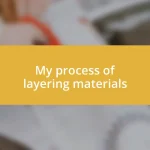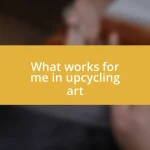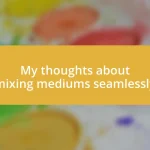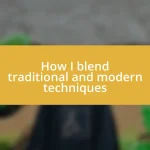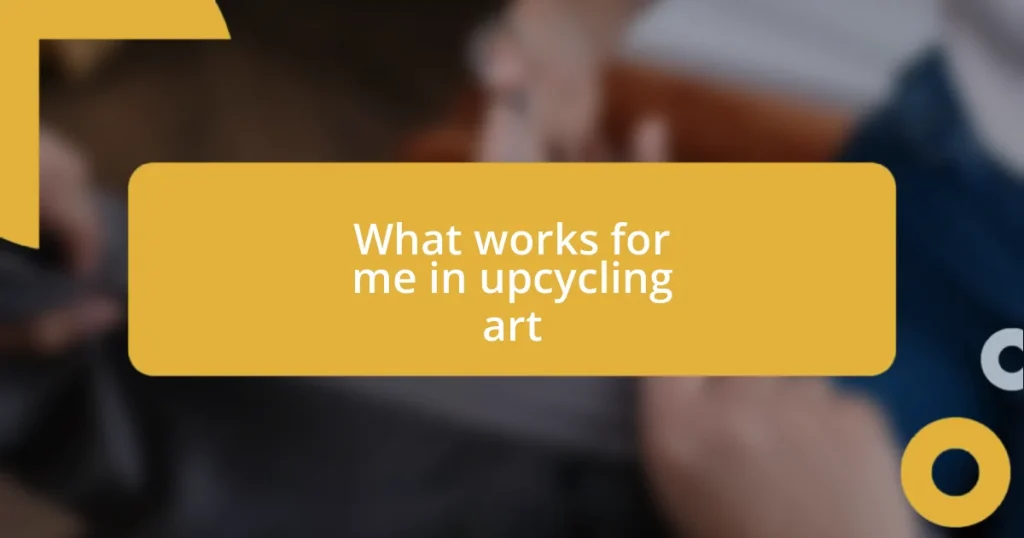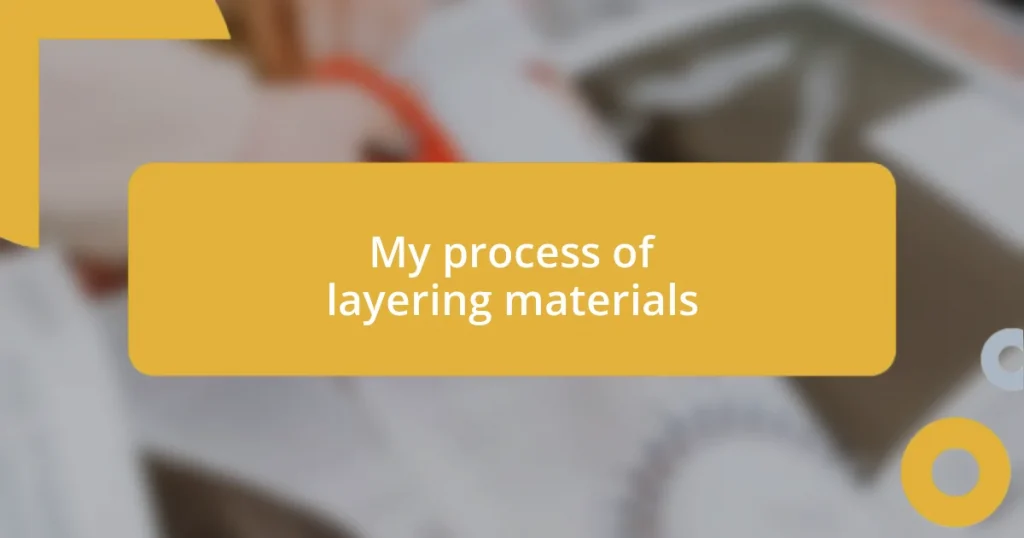Key takeaways:
- Upcycling art contributes to environmental sustainability by repurposing materials, reducing waste, and fostering community connections among artists.
- Choosing quality, versatile, and unique materials is crucial for successful upcycling projects, while safety considerations should not be overlooked.
- Enhancing upcycled art through texture, vibrant colors, and personal stories can create meaningful and visually captivating pieces.

Understanding upcycling art benefits
Upcycling art is not just a creative outlet; it also breathes new life into discarded materials, transforming them into something beautiful and meaningful. I remember a time when I turned an old wooden chair into a quirky plant stand; not only did I save it from the landfill, but I also felt a deep sense of accomplishment when it added character to my home. Have you ever experienced that thrill of creating something stunning from what others deemed useless?
One of the most rewarding aspects of upcycling is its positive impact on the environment. By repurposing materials, we reduce waste and lessen our carbon footprint. I find it incredibly satisfying to know that every piece I create contributes to a more sustainable world. How often do we consider the environmental stories behind our art?
Additionally, upcycling fosters a sense of community as people connect over shared values and initiatives. I’ve been part of a local workshop where artists gathered to exchange ideas and skills. The bonds formed in these spaces are remarkable—turning individual projects into collaborative movements that inspire change. Isn’t it amazing how art can unite us while making a difference?

Choosing materials for upcycling projects
When it comes to choosing materials for upcycling projects, the options are practically endless. I often find myself rummaging through thrift stores or digging through my own garage, unearthing treasures among what others consider trash. Recently, I spotted a stack of mismatched tiles that had been gathering dust. I couldn’t resist the idea of transforming them into a unique mosaic tabletop, a project that not only showcased my creativity but also honored the stories behind each piece.
Here are some tips on selecting materials for upcycling:
- Look for quality: Focus on items that are durable and have potential for transformation, like furniture or textiles.
- Consider versatility: I often choose materials that can serve multiple purposes; a wooden crate can be a shelf, a planter, or storage.
- Embrace imperfections: I love pieces with character—dents or scratches can add to the charm and uniqueness of the final product.
- Be mindful of safety: Always check for hazards, especially with old items. Removing lead paint or ensuring fabric is clean is crucial.
- Think about your audience: If I’m creating something for a community event, I consider popular trends while maintaining my personal touch.
Each material has a story waiting to be told, and by carefully selecting my materials, I make sure those stories are beautifully expressed in my art.

Tools needed for upcycling art
When diving into the world of upcycling art, I quickly learned that having the right tools makes all the difference. Basic tools like scissors, glue, and paint are essential, but I also find that unique items like old jewelry or fabric scraps can elevate my projects in unexpected ways. For instance, the last time I crafted a wall hanging from leftover fabric, those small, intricate tools allowed me to add delightful finishing touches that truly transformed the piece.
Exploring various tools has led me to discover that my creative process is often influenced by what I have on hand. I once turned a simple screwdriver into a design tool by using it to etch patterns into wet clay! It’s incredible how thinking outside the box can lead to innovative techniques. Just remember, while it’s fun to collect tools, what matters most is how you use them to bring your vision to life.
Lastly, I believe organization plays a crucial role in upcycling art. Having a designated space for tools not only keeps things tidy but also sparks inspiration when I see everything laid out. I often find that organizing my supplies leads to spontaneous project ideas fueled by creative energy. Do you have a go-to tool or system that inspires you to create?
| Tool | Description |
|---|---|
| Scissors | Essential for cutting various materials like paper, fabric, or cardboard. |
| Glue | A versatile adhesive for bonding materials together, from wood to fabric. |
| Paint | Used to add color and personality to your upcycled creations. |
| Old Jewelry | Can be repurposed as embellishments, adding unique charm to art pieces. |
| Scrap Fabric | Great for creating texture and depth in projects like quilts or wall hangings. |

Techniques for transforming waste items
Transforming waste items requires some creative techniques that can breathe new life into the ordinary. One approach I frequently employ is combining different materials—like using old glass jars as planters wrapped in natural fibers. The contrast not only enhances their aesthetic appeal but also inspires a conversation piece in my home. Have you ever thought about how something seemingly mundane could spark joy just by tweaking its presentation?
Upcycling furniture often fascinates me. I remember a time when I found an old wooden chair that looked ready for a bonfire. Instead of discarding it, I sanded down the surface and applied a vibrant coat of chalk paint. The transformation was not just physical; it felt as though I had rekindled its essence. Every brushstroke felt intimate, creating layers of history through new colors and textures. Can you imagine the stories that chair could tell if it had a voice?
Another technique that excites me is using unexpected materials as functional art. I’ve turned discarded wine corks into a stylish bulletin board. By gluing them onto a simple frame, I created a unique and practical piece that adds character to my workspace. It’s empowering to realize that the things we often overlook can serve a purpose beyond their original intent. What waste items have you come across that could benefit from a little imagination?

Successful upcycling project ideas
One of my favorite upcycling projects is turning old picture frames into shadow boxes. It’s amazing how a simple frame can transform into a beautiful display of memories or small treasures. For instance, I once filled a vintage frame with dried flowers and mementos from a meaningful trip, creating a piece that always brings a smile. Have you ever thought about how a framed snapshot of your cherished moments can become a work of art just by reimagining its function?
Another project I truly enjoyed was making decorative storage boxes from used cereal boxes. After cutting and folding them into more appealing shapes, I covered them with colorful wrapping paper and added some embellishments. The best part? They provided a stylish way to organize my craft supplies while also adding a pop of color to my workspace. Plus, nothing feels as satisfying as knowing I’ve reduced waste while enhancing my environment. What items do you have around that could serve a dual purpose with a little creativity?
I also love crafting herb planters from old tin cans. After washing them out, I added some paint and drilled holes in the bottom for drainage. Not only do they provide fresh herbs for my meals, but they also add a rustic charm to my kitchen. Each time I snip some basil or chives for cooking, I feel a deep connection to the process of creation and sustainability. Have you ever considered how everyday items can nourish both your body and creativity?

Tips for enhancing upcycled art
To enhance your upcycled art, I find that layering textures can truly bring a piece to life. I remember when I took a plain wooden shelf and adorned it with various fabrics, paint, and twine. The result? A stunning piece that not only showcases my creativity but also becomes a conversation starter for guests. Have you ever played with the idea of combining different textures in your art? It can add depth and intrigue that really captivates the viewer’s attention.
I’ve also discovered that incorporating vibrant colors can catch the eye and elevate an ordinary item into something extraordinary. One time, I infused an old metal sign with bold splashes of color. As I brushed on each hue, I felt a rush of excitement, watching the transformation unfold before my eyes. Color has a way of breathing life into upcycled pieces—what color palette speaks to you? Perhaps you’ll find that the right choices can foster joy and wonder in your creations.
Another tip I cherish is incorporating personal stories into your upcycled art. For instance, I took a vintage suitcase with memories of my grandparents and turned it into a stylish coffee table. Now, every time I glance at it, I’m reminded of family road trips and cherished moments. Have you considered how the stories embedded in your materials can add layers of meaning to your work? By connecting personal history to your art, you invite others into your narrative, making your creations resonate on a deeper level.

